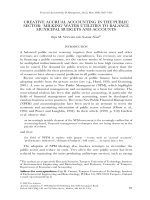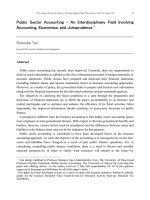Paradigms and public sector reform
Bạn đang xem bản rút gọn của tài liệu. Xem và tải ngay bản đầy đủ của tài liệu tại đây (3.5 MB, 263 trang )
Paradigms &
Public Sector
Reform
Public Administration of Bhutan
Lhawang Ugyel
Paradigms and Public Sector Reform
Lhawang Ugyel
Paradigms and Public
Sector Reform
Public Administration of Bhutan
Lhawang Ugyel
Australian National University
Australia
ISBN 978-3-319-40279-6
ISBN 978-3-319-40280-2
DOI 10.1007/978-3-319-40280-2
(eBook)
Library of Congress Control Number: 2016952834
© The Editor(s) (if applicable) and The Author(s) 2016
This work is subject to copyright. All rights are solely and exclusively licensed by the
Publisher, whether the whole or part of the material is concerned, specifically the rights of
translation, reprinting, reuse of illustrations, recitation, broadcasting, reproduction on
microfilms or in any other physical way, and transmission or information storage and retrieval,
electronic adaptation, computer software, or by similar or dissimilar methodology now
known or hereafter developed.
The use of general descriptive names, registered names, trademarks, service marks, etc. in this
publication does not imply, even in the absence of a specific statement, that such names are
exempt from the relevant protective laws and regulations and therefore free for general use.
The publisher, the authors and the editors are safe to assume that the advice and information
in this book are believed to be true and accurate at the date of publication. Neither the publisher nor the authors or the editors give a warranty, express or implied, with respect to the
material contained herein or for any errors or omissions that may have been made.
Cover illustration: © DV TRAVEL / Alamy Stock Photo
Printed on acid-free paper
This Palgrave Macmillan imprint is published by Springer Nature
The registered company is Springer International Publishing AG
The registered company address is: Gewerbestrasse 11, 6330 Cham, Switzerland
For Tshoki, Yonten and Deyzang: Thank you for your love and patience!
CONTENTS
1
Introduction
Part I
Public Administration of Bhutan
1
15
2
Paradigms of Public Administration
17
3
Ideal Types in Public Administration
53
4
Bhutan’s Approach to Public Administration
from Modernisation to the New Millennium
73
The Position Classification System and Bhutan’s Public
Administration in a New Era of Governance
95
5
Part II Implementation and Evaluation of the Position
Classification System Reforms
123
6
125
Evaluating the Position Classification System
vii
viii
CONTENTS
7
Dynamics of the Position Classification System Reforms
161
8
Dynamics of Public Sector Reforms
197
9
Conclusion
219
Appendices
235
Index
243
LIST
Fig. 1.1
Fig. 6.1
Fig. 6.2
Fig. 6.3
Fig. 6.4
Fig. 6.5
Fig. 6.6
Fig. 6.7
Fig. 6.8
Fig. 6.9
Fig. 6.10
OF
FIGURES
Administrative Map of Bhutan
What is your perception of the PCS? (%)
Source: Author’s own compilation
What do you think was the overall effect of the
PCS on the civil service? (%)
Source: Author’s own compilation
Opportunities for feedback (%)
Source: Author’s own compilation
Measures to ensure successful transition in place (%)
Source: Author’s own compilation
Implementation of PCS as per Policy Document
and Manual (%)
Source: Author’s own compilation
Perceptions of Positions and Occupational Groups (%)
Source: Author’s own compilation
Perceptions of the Recruitment, Selection
and Promotion System (%)
Source: Author’s own compilation
Perceptions of HRD System (%)
Source: Author’s own compilation
Adequate support and resources are provided
to achieve the performance targets (%)
Source: Author’s own compilation
Perceptions of the Remuneration and
Benefit System (%)
Source: Author’s own compilation
4
133
134
138
140
142
144
147
149
151
154
ix
x
LIST OF FIGURES
Fig. 7.1
Fig. 8.1
Appendix Fig. A
Cultural dimensions for Bhutan
Source: Author’s own compilation
Public sector reform trajectories
Source: Author’s own compilation
Responses based on location
182
198
239
LIST
Table 3.1
Table 4.1
Table 4.2
Table 5.1
Table 5.2
Table 5.3
Table 6.1
Appendix Table A
Appendix Table B
Appendix Table C
Appendix Table D
OF
TABLES
Ideal types of public administration
Seniority-based promotions under the
Cadre System
Fitting the Bhutanese administrative system
pre-2006 within the ideal types of public
administration
Objectives and aspects of the PCS
Major occupational groups
Fitting the Bhutanese Administrative system
post-2006 within the ideal types of public
administration
Summary of key findings
Description of respondents to the in-depth
interviews
Respondents by agency
Regression results of the responses
Respondents to the VSM 2008 by agency
in Australia
55
86
88
104
105
118
156
235
237
240
241
xi
CHAPTER 1
Introduction
SPREAD OF PUBLIC SECTOR REFORMS
Governments have long initiated public sector reforms. In doing so, they
have striven to improve existing systems and processes. In this sense,
‘reform’ indicates a ‘deliberate move from a less desirable (past) state to
a more desirable (future) state’ and implies that a ‘beneficial change’ will
take place (Pollitt and Bouckaert 2004, 15). Reforms are often introduced
as a response to shortcomings of a previous system (Hughes 2003) and
involve ‘doing the old things in different ways’ or discovering ‘new things
that need doing’ (Halligan 2001, 8). Numerous definitions of public sector reforms have been offered by various scholars. Turner and Hulme
(1997, 106) point out that one of the elements of the definition of administrative reform is ‘deliberate planned change to public bureaucracies’.
Barzelay and Jacobsen (2009, 332) view it as a ‘process of managerial
innovation in government’. Others, such as Pollitt and Bouckaert (2004,
6), view public sector reforms as a ‘means to multiple ends’. According
to Lane (1997, 12) public sector reform is something that ‘no government can do without’ and ‘since all governments attempt it, each and
every government must engage in it’. Even in earlier periods such as the
Persian, Egyptian and Chinese empires, reforms to public administrative
systems were implemented (Farazmand 1997). In more recent times, the
end of the colonial period led to an increase in the number of independent
states, adding to the urgency to engage in comparative public administra-
© The Author(s) 2016
L. Ugyel, Paradigms and Public Sector Reform,
DOI 10.1007/978-3-319-40280-2_1
1
2
L. UGYEL
tion (Jreisat 2010). In more recent decades, with changes in areas such as
the emergence of transnational networks, development of information and
communication technologies and global economic development, public
sector reforms have spread across countries extensively.
The spread and application of public sector reforms have not always
been uniform. In applying public sector reform, for instance, most
authors (e.g., Askim et al. 2010; Baker 2004; Cheung and Scott 2003;
Common 2001; Halligan 2001; Jones and Kettl 2004; Klitgaard 1997;
Nolan 2001; Olsen 2005; Pollitt and Bouckaert 2011; Wise 2002) agree
that reforms are dependent on the context and culture of the countries in which they are applied. The choice of reforms depends on:
different needs, political pressures and historical traditions (Aberbach
and Christensen 2003, 504); specific structural and cultural characteristics based on the ‘administrative arena’ and ‘administrative tradition’
(Capano 2003, 788); differences in national reform paths and reform
patterns (Hajnal 2005, 496); and the broader state–civil society relations
within which the reforms are embedded (Brandsen and Kim 2010, 368).
Even for countries seen as relatively similar in terms of development,
there have been apparent differences in the implementation of public
sector reforms. In a cross-country comparison of six developed countries, Gualmini (2008, 81) points out differences in the implementation of reforms between English-speaking nations (such as the USA and
the UK) and Continental European systems. Similarly, Torres (2004,
109–110) notes differences in market-oriented reforms and management of human resources between the Anglo-American experience and
continental European countries. Differences in implementation of public sector reforms also arise between Western and non-Western countries
whose state histories and development trajectories are radically different.
In the case of developing countries, the contextual differences within
which reforms are implemented are stark, and transfer of public sector reforms from developed countries to developing countries is often
fraught with inconsistencies and confusion during implementation. In
some developing countries, values such as hierarchy, kinship and communal networks continue to influence the performance of the public
sector (Andrews 2008; Cheung and Scott 2003; Klitgaard 1997). In
addition, it has been argued that elite actors in governance systems in
developing countries rarely encourage reforms since they gain from inefficient administrations (Baker 2004). Olsen (2005, 16) also argues that
adopting reforms based on Anglo-Saxon prescriptions is likely to have
INTRODUCTION
3
‘detrimental’ and ‘disastrous’ consequences, particularly when they are
made within short time frames and under tight budgetary constraints.
In the implementation of public sector reform, there has been a mixture of successes and failures. The range of results has been attributed
to both the nature of the reforms and variations in the context and culture of the public administrative systems when they were enacted. It is
often the case that when public sector reforms are initiated, the context
within which the reforms are applied is overlooked by the implementers.
As a result, there is a clash of values and culture during the implementation of the reform, leading to its ineffectiveness. Vigoda-Gadot and Meiri
(2007, 111) support this line of argument, pointing out that ‘cultural
and personal considerations’, such as values, values-fit and the compatibility of individuals with their changing organisational environment, climate and culture are not considered in the introduction of new reforms.
Understanding the national cultural variable is essential if we are to get an
‘understanding of the interplay between public institutions and the social
context’, as national cultures influence the ‘structure’ and ‘performance’
of public administration (Andrews 2008, 171–172), and this hints at why
administrative reforms vary in nature and follow different paths (Capano
2003, 782). One of the prerequisites for successful policy transfer is that
countries must have a good idea of the policy in the originating country
and the experiences of other countries with similar reform (Mossberger
and Wolman 2003); and that governments must be clear about the problem to be solved at home and consider experimenting with various methods before deciding on the combination that best addresses their needs
(Jones and Kettl 2004).
BHUTAN AND PUBLIC SECTOR REFORM
Amidst such a flurry of public sector reform initiatives, Bhutan, a small,
land-locked country wedged between China to its north and India to its
south (refer to Fig. 1.1 for an administrative map of Bhutan), has engaged
extensively in public sector reforms since the 1960s, when it opened
itself up to international engagement and initiated planned economic
development.
With a total land area of 38,394 sq. km inhabited by approximately
730,000 people (NSB 2014), Bhutan is a developing country with a per
capita income in 2013 of US$ 2330 (World Bank 2015). Bhutan’s pace
of development has been relatively fast. Within about 30 years, from
4
L. UGYEL
Fig. 1.1 Administrative Map of Bhutan
1980 to 2012, life expectancy increased by 21 years, expected years of
schooling by eight years and Gross National Income (GNI) per capita
by almost 470 % (UNDP 2013). The start of development activities in
Bhutan also resulted in changes to traditional institutions which were
based on a strong tradition of Tibetan Buddhism. Multiple public sector
reforms have been initiated between the 1960s and the current times. In
1972, the first set of civil service rules was drafted, establishing uniform
service conditions for all civil servants and setting standards for employment and promotions. In 1982, responding to changing needs and a
diversified environment, the Royal Civil Service Commission (RCSC)
was established to motivate and promote morale, loyalty and integrity
among civil servants by ensuring uniformity of personnel actions in the
civil service (RCSC 1982). In 1990, the cadre system was introduced
to minimise disparities in the entry-level grades and to provide career
advancement opportunities. The most recent public sector reform initiated by the Bhutanese government has been the Position Classification
System (hereafter referred to as PCS) implemented in 2006.The PCS
INTRODUCTION
5
represented a major tranche of public sector reforms including key components of performance management, recruitment, promotions and
training. Bhutan’s public sector has played an important role in the
development of the country, while simultaneously building its own institutions, organisations and capacities.
Bhutan’s public administration, as we shall observe in subsequent
chapters, has a distinct culture based on the predominant religion in
Bhutan (Tibetan Buddhism), and a large component of religious values percolates into the social and national culture. Many authors have
observed the integration and intertwining of Buddhist philosophies with
the state’s policy (e.g., Blackman et al. 2010; Mathou 2000; Rinzin
et al. 2007; Turner et al. 2011; Ura 2004). Fundamental Buddhist values such as compassion, respect for life, striving for knowledge, social
harmony and compromise have also impacted policymaking in Bhutan
(Mathou 2000). The concepts and practices of Buddhism are often
used as resources for the coordination of complex and interdependent
public policies (Hershock 2004). Blackman et al. (2010), for example,
agree that for new policies and processes to be successful in Bhutan,
they should integrate Buddhist principles and existing Bhutanese culture. The size of Bhutan’s public administration is small, and the number
of civil servants as of June 2012 was 23,909 (RCSC 2013), which was
approximately 3.4 % of the total population. In general, the definition of
the civil service in Bhutan includes all employees who are employed by
the Royal Civil Service Commission under the conditions of the Bhutan
Civil Service Rules and Regulations (BCSR 2012). The BCSR 2012
excludes categories of people for whom the rules are not applicable:
elected representatives; holders of constitutional offices and members or
commissioners; drangpons (judges) and drangpon rabjams of all courts
under the judiciary; Attorneys General; and personnel of armed forces
and the Royal Bhutan Police. In addition, employees of state-owned
enterprises are not included in the definition of civil servants in Bhutan.
This definition of civil service in Bhutan was prescribed in the early
1990s. Prior to that, Bhutan’s civil service also comprised monks, armed
forces personnel and employees of state-owned enterprises. For the purposes of this book, the term ‘civil servants’ will refer to those categories
of public officials defined as per the BCSR 2012, and the term ‘public
sector’ will refer to those agencies and organisations within which these
public officials are appointed.
6
L. UGYEL
MAIN OBJECTIVES OF THE BOOK
This book is divided into two parts, and each part serves its own as well
as interrelated purposes. The first part of the book describes the historical trajectory of Bhutan’s public administration from the 1600s till
recently. Bhutan, in general, is a relatively under-studied country. Only
a few researchers have worked specifically on public sector reforms in
Bhutan (e.g., Blackman et al. 2010; O’Flynn and Blackman 2009; Rose
1977). Thus, at the applied research level, this book is the first comprehensive study of the PCS and also one of the few studies conducted on
Bhutan’s modern administrative system. I use the notion of ‘paradigms’
as described by Thomas Kuhn (1970) to provide a framework for understanding changes in Bhutan’s public administration, in both a temporal
and systemic sense. Although Kuhn used paradigms to explain phenomena
in the natural sciences, the concept has been found to be useful in the
social sciences too. In the field of public administration, the paradigm
concept is particularly helpful in understanding the problems faced, and
how the public sector reforms selected to solve these puzzles shape the
characteristics of the government. Paradigms in public administration,
such as traditional public administration and new public management,
are helpful in studying the content and dynamics of policy change and
also in determining the dynamics of the field of public administration’s
identity and the manner in which governments are shaped and function
(Capano 2003; Henry 1975; Lovrich 1985). The concept of paradigms,
for the purposes of the book, draws out the notions of ‘exemplars’ and
‘paradigmatic changes’ in public administration. These exemplars help in
establishing ideal types of public administration in Bhutan. The notion of
paradigmatic change helps in understanding the translation of theory into
practice and the complexities that arise with it.
Through the ideal types, we shall observe that public administration
systems tend to exist in ‘hybrid’ forms. And this study, in general, contributes to the extant literature by explaining hybridity in public administration systems through the notion of paradigms. Using paradigms in public
administration to identify ideal types in public administration, I demonstrate that Bhutan’s public administration is an example of a system that
exhibits traits of the various paradigms and models of public administration. In doing so, this book also builds on renewed interest in other forms
of paradigms of public administration. There are emergent works on different paradigms, such as Drechsler’s (2013) notion of the Eastern and
INTRODUCTION
7
Islamic paradigms, in addition to the Western paradigm. Drechsler (2013,
50) argues that in the field of public administration post the new public
management (NPM) era, there has not been a cohesive paradigm, and in
its place are several ‘paradigmettes’. Using the notion of paradigmettes,
this book provides a better understanding of how hybrid systems of public
administration and management develop in situ and how they influence
the implementation of public sector reforms. It lends support to the argument that when implementing public sector reforms, it is important to
consider the administrative context and the culture and values embedded
with the reforms. It is often the case that when public sector reforms are
initiated, the context within which the reforms are applied is discounted
by the implementers. As a result, there are clashes in values and culture
during the implementation of the reform, leading to its ineffectiveness.
The second part of the book discusses the dynamics of implementing
public sector reforms by examining the implementation of the PCS in
Bhutan’s civil service. The PCS is important because it represents a comprehensive set of public sector reforms comprising five components. These
components can be classified as either paradigm-shift policies or normal
policymaking (this classification is based on Peter Hall’s [1993] concept of
paradigms in policymaking and is comprehensively discussed in Chap. 5).
The categorisation of the PCS into normal policymaking and paradigmshift policies also highlights the effect of these reforms, depending on the
context and culture within which they are applied. The PCS presents itself
as a policy within which various aspects of the policy cycle process can be
assessed. The stages of the policy cycle such as policy formulation, decisionmaking and implementation are clearly visible in the PCS. This makes the
evaluation of the PCS comprehensive based not only on its outcome but
also the various process and other programmatic dimensions. Just a few
years into the implementation of the PCS, it received a slew of public
criticism. Such strong reactions to the PCS prompted the prime minister,
in a gathering with senior civil servants in February 2009, to declare that
the PCS was a ‘mistake’ which had weakened the civil service with its
‘rules and regulations’, and that it would be reviewed (Kuensel 2009).
The sharp negative criticism came as a surprise to those involved in the
formulation and implementation of the PCS: five years of extensive work
went into the process of conceptualisation and formulation of the PCS,
involving numerous international advisors and consultants and various
committees and focal persons representing all agencies in the Bhutanese
government. Study visits to countries with successful experience of public
8
L. UGYEL
sector reforms were also arranged. With no official or other study of the
PCS conducted since its implementation, the question remained as to why
it was seen to have failed and what factors prompted this view. The main
hypothesis of the second part of the book is that the dynamics of public
sector reform are largely influenced by the administrative context and culture of the country in which reforms are applied. Supporting this hypothesis, the first part of the book, which covers paradigms and ideal types
in the field of public administration, provides the administrative context
within which reforms are applied and also an insight into the nature and
embedded values of the public sector reforms to be applied. The other key
dimension and variables that lend support to the hypothesis are the scope
and timing of evaluation and the drivers of change and their interactions.
They serve the purpose of: first, accounting for certain influential variables
on the dynamics of public sector reforms such as policy transfer aspects;
and second, factoring out variables such as change management, stakeholder participation and other formulation and implementation issues that
may influence dynamics other than the administrative context and culture.
The second part of the book speaks to the gap in the extant literature on how to evaluate public sector reforms. Despite the proliferation
of public sector reforms, there is a dearth of post-reform evaluation literature, both in theory and practice. Although there have been some
evaluation studies conducted by academic researchers (such as Goldfinch
1998; McNamara et al. 2009; Pollitt and Bouckaert 2011; Scheers et al.
2005) and international institutions (such as ADB 2009; OECD 2005;
World Bank 2008) who have attempted to fill the void, there remain fundamental issues that make evaluation of public sector reforms a challenging field to study. In practice, although evaluations have been conducted
by governments, they have been used in a relatively limited and sporadic
manner (Thoenig 2003). Through the experience of the implementation of the PCS in Bhutan, this book highlights some of the problems
in the post-reform evaluation literature in public administration. It also
points to debate about convergence versus divergence of public sector
reforms. In doing so, the book examines points of convergence and divergence in public sector reforms based on the implementation of the PCS
in Bhutan. It argues that while on the one hand, factors such as globalisation and technological development have led to convergence, on the
other hand, contextual and cultural differences have led to divergence.
To examine the cultural differences, Geert Hofstede’s work on cultural
studies has been utilised. Thus, another significant contribution of the
INTRODUCTION
9
book is that it generates original data for Bhutan using Geert Hofstede’s
Values Survey Module (VSM 2008). Hofstede’s data set does not include
data for Bhutan, and this book is the first study that has been conducted to
determine the cultural dimensions using the VSM 2008. Although there
have been some studies of Bhutanese cultural values, Hofstede’s VSM
2008 has been helpful because of its extensive use of cross-country comparisons, organisational studies and direct relations of values to specific
organisational characteristics. This book also provides some useful guidance on how to better formulate, introduce and implement public sector
reforms in Bhutan. Further, using Bhutan as a case study will be useful for
the field of comparative public administration. It can be concluded that
the comparative study of administrative structures, functions and behaviours across organisational and cultural boundaries helps to improve the
‘reliability’ and ‘applicability’ of public administration knowledge (Jreisat
2010, 612). Closely analysing the ways in which different countries ‘selectively emphasise and execute different elements of reform’ leads to a better
understanding of how global policy ideas are adopted and implemented
within the national context (Brandsen and Kim 2010, 369).
OVERVIEW OF THE BOOK
This book is divided into two parts. The first part contains four chapters and describes the Bhutanese public administration by examining various paradigms and ideal types of public administration. Chapters 2 and
3 provide the theoretical framework for the book. Chapter 2 includes an
explanation of how Thomas Kuhn’s notion of paradigms based on the
natural sciences is applied in the social sciences, and in particular, the field
of public administration. This chapter includes a comprehensive analysis
of the various paradigms of public administration and it examines some
of their main theoretical foundations as well as their characteristics. These
paradigms of public administration help in describing a typology of ideal
types in public administration that explains the characteristics of public
administration systems. Discussions on these ideal types of public administration comprise Chap. 3. It builds on the two important characteristics of paradigms, that is, ‘exemplars’ and ‘world views’, to identify ideal
types in the field of public administration. These ideal types, based on
the paradigms of public administration, help to determine the characteristics of public administrative systems. This chapter also argues that, in
reality, public administrative systems do not always fit into one particular
10
L. UGYEL
paradigm. Public administration systems exist as hybrid systems that are
layered with characteristics of various paradigms overlapping one another.
Chapters 2 and 3 help set the tone for Chap. 4 on Bhutan’s public
administration history (prior to 2006) and Chap. 5 on the PCS and
Bhutan’s public administration after 2006. Chapter 5 provides a historical anecdote of Bhutan’s public administration from the seventeenth century to the mid-twentieth century. It also describes public administration
reforms initiated from the mid-twentieth century, when modernisation
policies transformed the political institutions and the socio-economic conditions of the country, until 2006, that is, when the PCS was implemented
in Bhutan. Chapter 5 discusses the PCS reform initiative and also provides
an insight into how some of the recent governance reforms in Bhutan
have changed the public administration system. The first part of the book
examines paradigms and ideal types in the field of public administration.
The paradigm concept helps in explaining dynamics and interactions of
the application of public sector reforms within the context of the ideal
types. The paradigm approach to policymaking helps in differentiating
the impacts and tensions of paradigmatic change reforms and incremental
change reforms. Based on historical and recent reforms, the Bhutanese
administrative system has been mapped onto the ideal type typology to
show hybridity with a mix and layering of characteristics of paradigms.
The second part of the book, which examines the dynamics of implementing and evaluating the PCS, covers the remaining three chapters.
Chapter 6 discusses the evaluation of the PCS, includes a brief description of the methodology of the book, and provides a basis for using a
mixed-method approach to generating information for the research. This
chapter evaluates the policy based on the processes involved in formulating and implementing the PCS as well as the various components of
the PCS. Chapter 7 discusses the dynamics of the PCS and includes an
analysis of the dimensions of policy processes, including the formulation,
implementation and evaluation of public sector reforms. Some of the key
discussions within these dimensions centre on policy transfer, change
management, stakeholder participation and the impact of culture and values. Throughout the discussions, and especially when it includes components of the PCS, this chapter segregates the discussions into paradigmatic
change reform and normal policymaking. Such categorisation helps in
linking the book to the notion of paradigms and provides a better sense of
the dynamics of public sector reforms. Chapter 8 synthesises the findings
on the implementation of the PCS in Bhutan’s civil service and connects
INTRODUCTION
11
it to broader discussions on public sector reforms. It discusses the trajectory of public sector reform and points of convergences and divergences
within this trajectory. Chapter 8 also discusses the debate about theory
and practice of public sector reforms and the consequences of the dynamics of public sector reform.
The final chapter, Chap. 9, concludes bringing the discussion to a close
by summarising the answers to the main objectives of the book. It also
highlights some policy and theoretical implications of the findings and
describes how the book contributes to the broader knowledge on public
administration.
REFERENCES
Aberbach, Joel D., and Tom Christensen. 2003. Translating Theoretical Ideas into
Modern State Reform: Economics-Inspired Reforms and Competing Models
of Governance. Administration and Society 35(5): 491–509.
ADB (Asian Development Bank). 2009. ADB Support for Public Sector Reforms in
the Pacific: Enhance Results Through Ownership, Capacity, and Continuity.
Manila: ADB.
Andrews, Christina W. 2008. Legitimacy and Context: Implications for Public
Sector Reform in Developing Countries. Public Administration and
Development 28: 171–180.
Askim, Jostein, Tom Christensen, Anne Lise Fimreite, and Per Laegreid. 2010.
How to Assess Administrative Reform? Investigating the Adoption and
Preliminary Impacts of the Norwegian Welfare Administrative Reform. Public
Administration Review 88(1): 232–246.
Baker, Bruce. 2004. Uneasy Partners: Democratisation and New Public
Management in Developing Countries. In Contesting Public Sector Reforms,
eds. Pauline Dibber, Geoffrey Wood, and Ian Roper. New York: Palgrave
Macmillan.
Barzelay, Michael, and Annie Sofie Jacobsen. 2009. Theorizing Implementation of
Public Management Policy Reforms: A Case Study of Strategic Planning and
Programming in the European Commission. Governance: An International
Journal of Policy, Administration and Institutions 22(2): 319–334.
Blackman, Deborah, Janine O’Flynn, and D.P. Mishra. 2010. Can Strategic
Human Resource Management Enable Gross National Happiness? International
Journal of Commerce and Management 20(3): 232–245.
Brandsen, Taco, and Sunhyuk Kim. 2010. Contextualizing the Meaning of Public
Management Reforms: A Comparison of Netherlands and South Korea.
International Review of Administrative Sciences 76(2): 367–386.
12
L. UGYEL
Capano, Giliberto. 2003. Administrative Traditions and Policy Change: When
Policy Paradigms Matter. The Case of Italian Administrative Reform During
the 1990s. Public Administration 81(4): 781–801.
Cheung, Anthony B.L., and Ian Scott. 2003. Governance and Public Sector
Reforms in Asia: Paradigms, Paradoxes and Dilemmas. In Governance and
Public Sector Reforms in Asia: Paradigm Shifts or Business as Usual, ed. Anthony
B.L. Cheung and Ian Scott. New York: Routledge Curzon.
Common, Richard. 2001. Public Management and Policy Transfer in Southeast
Asia. Hampshire: Ashgate Publishing Company.
Drechsler, Wolfgang. 2013. Three Paradigms of Governance and Administration:
Chinese, Western and Islamic. Society and Economy 35(3): 319–342.
Farazmand, A. 1997. Professionalism, Bureaucracy, and Modern Governance: A
Comparative Analysis. In Modern Systems of Government, ed. A. Farazmand,
Chap. 2, 48–55. Thousand Oaks: Sage.
Goldfinch, Shaun. 1998. Evaluating Public Sector Reform in New Zealand: Have
the Benefits Been Oversold? Asian Journal of Public Administration 20(2):
203–232.
Gualmini, Elisabetta. 2008. Restructuring Weberian Bureaucracy: Comparing
Managerial Reforms in Europe and the United States. Public Administration
86(1): 75–94.
Hajnal, Gyorgy. 2005. The Spirit of Management Reforms. Public Management
Review 7(4): 495–513.
Hall, Peter A. 1993. Policy Paradigms, Social Learning, and the State: The Case of
Economic Policymaking in Britain. Comparative Politics 25(3): 275–296.
Halligan, John. 2001. Comparing Public Sector Reform in the OECD. In Public
Sector Reform: An International Perspective, ed. Brendan C. Nolan. New York:
Palgrave.
Henry, Nicholas. 1975. Paradigms of Public Administration. Public Administration
Review 35(4): 378–386.
Hershock, Peter D. 2004. Bhutanese Public Policy in the ‘Century of
Independence’. Journal of Bhutan Studies 11: 89–111.
Hughes, Owen E. 2003. Public Management & Administration: An Introduction,
3rd edn. New York: Palgrave Macmillan.
Jones, Lawrence R., and Donald F. Kettl. 2004. Assessing Public Management
Reform Strategy in an International Context. In Research in Public Policy
Analysis and Management. Bingley: Emerald Group Publishing Limited.
Jreisat, Jamil. 2010. Comparative Public Administration and Africa. International
Review of Administrative Sciences 76(4): 612–631.
Klitgaard, Robert. 1997. Cleaning Up and Invigorating the Civil Service. Public
Administration and Development 17: 487–509.
Kuensel. 2009. PCS Did Not Fail, Implementers Did. Kuensel, February 18.
Kuhn, Thomas. 1970. The Structure of Scientific Revolutions, vol 2. Chicago: The
University of Chicago.
INTRODUCTION
13
Lane, Jan-Erik. 1997. Public Sector Reform: Only Deregulation, Privatization and
Marketization? In Public Sector Reform: Rationale Trends and Problems, ed.
Jan-Erik Lane. London: Sage Publications.
Lovrich, Nicholas P. 1985. Contending Paradigms in Public Administration: A
Sign of Crisis or Intellectual Vitality? Administration and Society 17(3):
307–330.
Mathou, Thierry. 2000. The Politics of Bhutan: Change in Continuity. Journal of
Bhutan Studies 2(2): 250–262.
McNamara, Gerry, Joe O’Hara, Richard Boyle, and Conor Sullivan. 2009.
Developing a Culture of Evaluation in the Irish Public Sector: The Case of
Education. Evaluation 15(1): 101–112.
Mossberger, Karen, and Harold Wolman. 2003. Policy Transfer as a Form of
Prospective Policy Evaluation: Challenges and Recommendations. Public
Administration Review 63(4): 428–440.
Nolan, Brendan. 2001. Public Sector Reform. Basingstoke: Palgrave Macmillan.
NSB (National Statistical Bureau). 2014. Statistical Yearbook of Bhutan 2013, ed.
National Statistical Bureau. Thimphu, Bhutan.
OECD (Organisation for Economic Co-operation and Development). 2005.
Performance-Related Pay Policies for Government Employees.
O’Flynn, Janine, and Deborah Blackman. 2009. Experimenting with Organisational
Development in Bhutan: A Tool for Reform and the Achievement of MultiLevel Goals? Public Administration and Development 29: 133–144.
Olsen, Johan P. 2005. Maybe It Is Time to Rediscover Bureaucracy. Journal of
Public Administration Research and Theory 16(1): 1–24.
Pollitt, Christopher, and Geert Bouckaert. 2004. Public Management Reform: A
Comparative Analysis, 2nd edn. Oxford: Oxford University Press.
———. 2011. Public Management Reform: A Comparative Analysis, 3rd edn.
Oxford: Oxford University Press.
RCSC (Royal Civil Service Commission). 1982. Royal Charter of the Royal Civil
Service Commission, 1982, ed. RCSC. Thimphu, Bhutan.
———. 2013. Civil Service Statistics (December 2012). Thimphu, Bhutan.
Rinzin, Chhewang, Walter J.V. Vermeulen, and Pieter Glasbergen. 2007. Public
Perceptions of Bhutan’s Approach to Sustainable Development in Practice.
Sustainable Development 15: 52–68.
Rose, Leo. 1977. The Politics of Bhutan. Ithaca, NY: Cornell University Press.
Scheers, Bram, Miekatrien Sterck, and Geert Bouckaert. 2005. Lessons from
Australian and British Reforms in Results-Oriented Financial Management.
OECD Journal on Budgeting 5(2): 133–162.
Thoenig, Jean-Claude. 2003. Formal Theory and Public Administration. In
Handbook of Public Administration, ed. B. Guy Peters and Jon Pierre. London:
Sage.
14
L. UGYEL
Torres, Lourdes. 2004. Trajectories in Public Administration Reforms in European
Continental Countries. Australian Journal of Public Administration 63(3):
99–112.
Turner, Mark, Sonam Chuki, and Jit Tshering. 2011. Democratization by Decree:
The Case of Bhutan. Democratization 18(1): 184–210.
Turner, Mark, and David Hulme. 1997. Governance Administration and
Development. London: Macmillan Press Ltd.
UNDP. 2013. Human Development Report 2013. In The Rise of the South:
Human Progress in a Diverse World. />Country-Profiles/BTN.pdf.
Ura, Karma. 2004. Peasantry and Bureaucracy in Decentralization in Bhutan.
Chiba: Institute of Developing Economies.
Vigoda-Gadot, Eran, and Sagie Meiri. 2007. New Public Management Values and
Person-Organization Fit: A Socio-Psychological Approach and Empirical
Examination among Public Sector Personnel. Public Administration 86(1):
111–131.
Wise, Lois Recascino. 2002. Public Management Reform: Competing Drivers of
Change. Public Administration Review 62(5): 555–567.
World Bank. 2008. Public Sector Reform: What Works and Why? Washington, DC:
World Bank.
———. 2015. />
PART I
Public Administration of Bhutan









